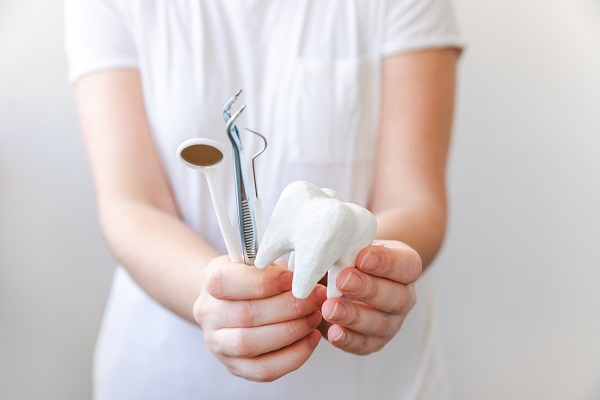A Dentist Explains 3 Dental Restoration Procedures

If you have cavities or are experiencing fractured or missing teeth, you understand the need for dental restorations. However, it is more than just the appearance of your smile that is at stake if you do not treat these issues. Tooth damage can cause serious problems down the road if it is not remedied in a timely manner.
A tooth that is cracked or chipped can be very painful, and the pain may persist depending on the extent of the damage. Exposed soft tissues or nerves may be to blame for this. A break in tooth enamel is also problematic because bacteria can now easily penetrate the tooth, increasing the risks of serious tooth decay. Because the decay can progress at a much faster rate, it may require more extensive dental work if the treatment is delayed. This can also increase the risks of infection and tooth loss.
A missing permanent tooth should always be taken seriously, even if it is towards the back of the mouth and is not noticeable to others. Lost teeth can lead to severe damage to surrounding teeth as a result of excess pressure and biting force. Jaw pain can also occur, along with alignment issues, digestive problems, and even trouble with speech. Missing teeth often affect the oral health of the entire mouth if not corrected as soon as possible.
Fortunately, there are a wide variety of restoration options available, with the one that is right for you depending on what type of dental issues you are experiencing. Your dentist can walk you through the types of procedures and help you determine which one will fit your needs.
Types of dental restoration procedures
There are many restoration options for patients who need to repair or replace decayed, broken, or missing natural teeth. There are many factors to consider, from recovery time and follow-up care to the materials and tooth structure needed. These common options are used in many situations where tooth damage or loss is an issue.
1. Dental fillings
Dental fillings are perhaps the most common type of restoration procedure that a dentist does. When a patient's tooth has a cavity, bacteria create a hole that leads to pain. Over time, that hole can become a much larger problem. Luckily, a dentist can stop the problem in its tracks by providing a filling for the patient. The filling, which can be made of gold, silver, or a composite resin that matches the tooth's natural color, fills in the cavity in the tooth. The patient feels less pain and can go back to eating and drinking normally.
2. Removable dentures
Sometimes, a patient has more fractured or missing teeth than fillings can help with. In these cases, a dentist may recommend that the patient be fitted for dentures. These common dental restorations are available as partial or full sets of teeth and are removable. Created using acrylic resin, dentures are sometimes used in combination with metal attachments to help hold them in place. Sometimes, dentures are created in a laboratory and take several weeks to be complete. Other times, same-day options are available.
3. Dental implants
Some patients who need many or all of their teeth to be replaced do not want to use removable dentures. Depending on their dental needs, these patients may be good candidates for dental implants. Implants are titanium rods that are inserted into the gums. Then, an abutment is attached to the rod to hold the false teeth in place. These teeth are known as crowns. Receiving dental implants can be a fairly lengthy process, but when it is complete, the patient has a full set of permanent teeth. They should remain intact and healthy as long as the person brushes and flosses daily as well as sees the dentist regularly.
Choosing the right restoration
Choosing the right restoration option depends on several factors. First, your dentist determines whether you have minor or major dental health issues and how they should be addressed. If you only need a couple of fillings, then you can typically receive them the same day. If your dentist decides that you need a partial or full set of false teeth, you need to decide between dentures or dental implants. Common deciding factors include the health of your jawbone and how many teeth you need to have replaced.
Conclusion
Do not let yourself go through life with the pain and embarrassment of broken or missing teeth. Talk to your dentist to see what your options are for dental restorations.
Request an appointment here: https://whiteflintfamilydental.com or call White Flint Family Dental at (301) 273-1085 for an appointment in our Rockville office.
Check out what others are saying about our dental services on Yelp: Dental Restorations in Rockville, MD.
Recent Posts
Wondering whether a cracked tooth can be saved by a dentist? Read on to find out. If a cracked tooth is damaged beyond what can be repaired, then a dentist may recommend having the tooth extracted and replaced with a fixed dental bridge, partial denture, or implant-supported dental crown.The methods used to treat a cracked…
Are you in need of dental restoration and don’t know where to turn? You are not alone. Countless patients ask themselves this nagging question daily. We all want to have the most beautiful and bright smile but aren’t sure how to achieve our goal. Fortunately, there are solutions that you can count on. There are many…
A dental restoration is a treatment that can help restore your appearance and protect damaged teeth from future harm. There is a range of dental restoration options available, and deciding which is right for you can be a challenge. This guide offers insights into the questions you should ask when choosing the right dental restoration…
Dental restorations are dental treatments that restore tooth damage and missing teeth. Treatment restores the look, feel and function of the patient’s teeth. Many dentists recommend dental restoration for chipped, cracked, broken and missing teeth.There are several different treatment options that patients have available to fix damaged teeth. Common types of dental restoration procedures are…


